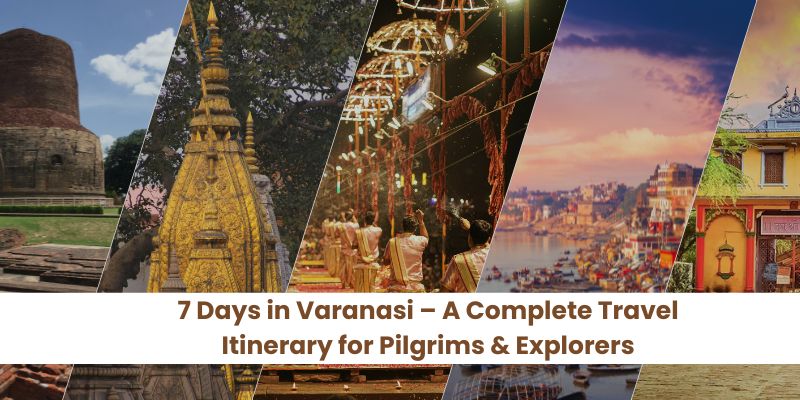


Varanasi, the spiritual capital of India, is more than just a city—it’s a living, breathing legend. Known as Kashi, the “City of Light,” and revered as one of the oldest inhabited cities in the world, Varanasi offers a blend of mysticism, devotion, culture, and chaos that few places on Earth can match.
Whether you're a pilgrim seeking moksha or an explorer chasing timeless culture, a 7-day trip to Varanasi can offer the perfect balance of both. This itinerary is crafted to help you experience the true essence of Varanasi—from its sacred temples to its buzzing alleys, from peaceful ashram life to the thunderous energy of Ganga Aarti.
Let’s begin the journey.
Start your journey by arriving in Varanasi, preferably by midday. For those seeking peace and affordability, Shree Gayatri Charitable Trust Ashram offers a calm and spiritually uplifting environment for your stay. Located conveniently near the ghats and Kashi Vishwanath Temple, the ashram provides simple accommodation with all essential amenities, ideal for both solo travelers and families.
Spend your first evening walking along the ghats—from Assi Ghat to Dashashwamedh Ghat. Let the Ganges wind whisper its stories as you absorb the energy of the city.
Don’t Miss:
Begin early with Subah-e-Banaras at Assi Ghat—witness morning aarti, classical music performances, and group yoga with the rising sun over the Ganga.
Then proceed on your temple trail, covering:
Lunch Tip: Try a sattvik meal or prasadam served at the ashram, or dine at a nearby vegetarian thali restaurant.
Evening: Relax at Shree Gayatri Charitable Trust Ashram—maybe attend an evening bhajan or engage in a silent meditation.
Dedicate this day to the heritage and diversity of Varanasi’s famous ghats. Each ghat here has a story, an emotion, a pulse:
Assi Ghat – The southernmost and one of the liveliest ghats, known for early morning yoga sessions, Subah-e-Banaras program, and a youthful energy.
Optional Experience: Take a sunset boat ride—the view of the city from the Ganga during golden hour is unforgettable.
Ashram Activity Suggestion: Join an evening group satsang or discourse at the ashram, and enjoy the serenity post the day’s spiritual saturation.
Travel just 10 km from Varanasi to Sarnath, where Lord Buddha gave his first sermon after enlightenment.
Must-visit places in Sarnath:
Sarnath offers a contrast—tranquility amidst ruins, silence in place of chants, making it an essential part of any Varanasi itinerary.
Return to Varanasi by evening. Light a diya at the ghat in gratitude for the wisdom received.
Today is your cultural immersion day.
Morning: Take a guided heritage walk through the lanes of Chowk and Vishwanath Gali—see local markets, old havelis, and hear legends passed down for generations.
Afternoon Food Trail:
Evening: Visit a Banarasi silk weaving workshop in the Madanpura or Lallapura area—watch the looms in action, and maybe buy a souvenir.
Optional: Attend a classical music or dance performance (check local event boards or ask at your ashram desk).
Spend this day slow and soulful at your ashram—Shree Gayatri Charitable Trust Ashram. Connect with inner peace, detached from the chaos of the outer world.
Activities you can engage in:
This day lets you absorb everything you've seen so far. Silence reveals meanings that noise hides.
Tip: Walk barefoot in the ashram garden, sip herbal tea, and just listen to the bells, birds, and breeze.
Your final day is for spiritual closure and souvenirs.
Morning: Take a holy Ganga snan (ritual bath) at the ghats, offer prayers, and visit Hanuman Ghat or Sankat Mochan Mandir.
You can also perform simple pujas or rituals with help from the ashram or local priests.
Shopping Ideas:
Don’t forget to take one last look at the ghats from the boat or ghat-top. That view will live in your heart forever.
Where to Stay – Why Ashram Life Wins
Staying in an ashram like Shree Gayatri Charitable Trust isn’t just about saving money—it’s about experiencing Varanasi the way sages did.
Varanasi isn’t just a destination. It’s a mirror. It reflects your soul, your karma, your questions, and your peace. In these 7 days, whether you came as a tourist, pilgrim, or explorer—you will leave with something more: clarity, contentment, and a calling to return.
This ancient city doesn’t just host you—it transforms you.
Q1. What’s the best time to visit Varanasi?
October to March is ideal. Pleasant weather, festivals, and winter delicacies await.
Q2. Is 7 days too much for Varanasi?
Not at all. With temples, ghats, cultural hubs, food, and places like Sarnath, 7 days allows a wholesome experience.
Q3. How much does ashram stay cost in Varanasi?
At Shree Gayatri Charitable Trust Ashram, stays are affordable, often donation-based or fixed nominal rates (~₹800–₹2000 per night depending on room and duration).
Q4. Can foreigners stay in ashrams?
Yes. Most ashrams welcome spiritual travelers from across the globe. Carry ID and maintain decorum.
Q5. What rituals can I do in Varanasi as a pilgrim?
Ganga snan, pind daan, rudrabhishek, satyanarayan katha, and daily pujas at temples are common. Your ashram can assist in arranging them.
If you're ready to immerse in the eternal spirit of Kashi, plan your journey, pack your prayer, and let Varanasi guide you inward.